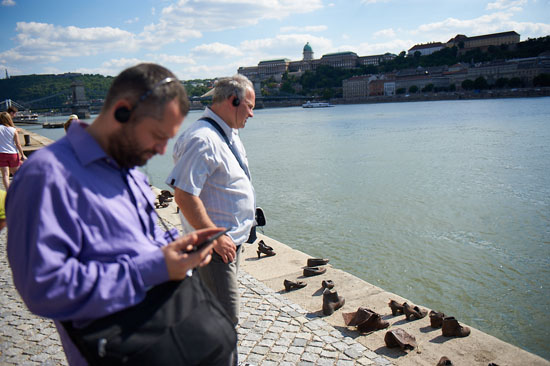It Happened Here, Right Here

By Kim Simon, Martin Šmok, and Andrea Szönyi

(Teaching with Testimony participants at the Shoes on the Danube memorial in Budapest)
There are two remaining synagogues in the city of Piotrków Tribunalski. Both are used today by the city's public library. HOW? Piotrków was the city where the Nazis established the first modern ghetto one month after the fall of Poland, in October 1939. The synagogues were desecrated, used as stables and assembly points before mass shootings. The last inhabitants of the ghetto not sent for forced labor were murdered in the temples.
In the smaller of the two synagogues, patrons or visitors can still see, behind the metal stacks of children's books, remains of the original Aron Kodesh painting and decoration riddled with bullet marks. In the great synagogue, next door, the library also provides computers and internet access. It is on these computers that members of the public may be given a chance to view and listen to testimonies from the Institute’s Visual History Archive about what happened in that very place—and to whom it happened—and through the connection between the individual stories and the place itself, there is opportunity to fill at least a fraction of the void visible throughout the city.
In the first five years of its existence, the Shoah Foundation engaged in a large-scale effort to collect testimonies in, at its height, 30 countries simultaneously. This simultaneity clarified for all involved, the innate and continual cycle of local-to-global practice. The collecting of testimonies in cities such as Los Angeles, Caracas, Miami, Paris, Vilnius, Kyiv, Johannesburg, and Sydney in 24-hour daily and weekly succession allowed the Institute not only to build the Visual History Archive but also to glimpse and appreciate the specificity of the places, communities, context, and individuals who had the courage to share their life stories.
The genocide of European Jewry—and those labeled as Jews by the racist laws—created a void that is still felt on many levels. Entire communities were wiped out, Jewish quarters abandoned and often leveled, synagogues desecrated. Paradoxically, the former existence of these communities remains almost touchable: buildings designed, city districts built, factories and theaters set up and operated, sports clubs founded by the people whose very existence is now forgotten. Additionally, the sites of several stages of the eradication of these people are still there: local ghettos, various places where Jews were concentrated before deportations, train stations, hiding places, and in many cases even killing sites.
Using testimony and working with local partners serve to deconstruct the notion of a separate, "Jewish" narrative being externally forced and applied, by working to reveal together, the history of local Jewish populations, which is an integral part of national history in particular locations. By bringing local personal stories back to the local sites through the use of the testimonies at those sites, it is possible to disrupt the awkward silence that lives on in these spaces. While unable to fill the void, it at least begins to address a gap in social historical memory.
The Visual History Archive and the capacity to search, retrieve, and view testimonies provide an endless opportunity to explore the depth and breadth of when something occurred and where it occurred. With such a vast trove of individual memories, this periscopic vision orients the viewer—the learner—to a base line of context from which the rest of a testimony “reading” can follow.
The level on which a testimony piece could be localized can include a city, a village, a street, or a school where life trajectories of former students could be explored. Dr. Monika Mezei, a history teacher at Berzsenyi High School in Budapest, is able to choose a clip of testimony from a former pupil, Tom Lantos, who went on to become a U.S. citizen and congressman from California. She is able to choose a particular clip of Rep. Lantos (who passed away in 2008), who describes with humor and great detail his experience in his Latin class in 1943, learning specific skills and tricks to memorize a particular aspect of the lesson. The students in her Latin class today can view and study this clip together with other clips, either by itself or within a larger lesson.
This clip, just an example of so many, in multiple languages, provides a small glimpse into the immediacy and specificity of connection to history and memory in a particular context. The students are drawn in by the connection to their current space and experience, the relevance sparking further interest and questions, along with an opportunity for further knowledge. They are invited to dig deeper and to consider whether or how the history and experience of that individual are relevant. The outcomes of the lesson are larger, surrounding the analysis of primary sources, the knowledge of specific events of the Holocaust in Hungary, and the understanding of various individuals within a particular time and place, but Mezei’s path to these educational outcomes is covered by the specific and localized touch points geared toward her group of students.
Because of the indelibility of the testimony, there is a chance that the knowledge gained, the historical information, the critical thinking, and social emotional learning will remain with students long after the class is over. This local approach provides educators and students today, and for the future, an opportunity to go beyond the surface, to participate and contribute actively in their own learning. The relevance and particularity are partially established through connection of place, and the distance of time collapses because of the story’s universality.
By providing educators and students with local personal accounts, technology to access them, and educational scaffolding to make them relevant and meaningful, there is an opportunity to facilitate the understanding of history—and future—as a sum of individual human lives being lived, to contribute to a generational shift, not only a commitment today or the next five years but a commitment for the long term.